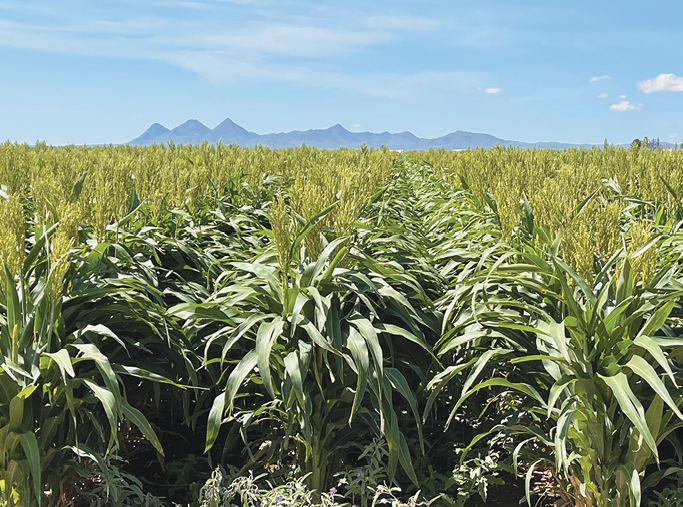Guide A-131
Revised by Phillip Lujan, Jesus Barraza, and Leslie Beck
College of Agricultural, Consumer and Environmental Sciences, New Mexico State University
Author: Respectively, Extension Plant Pathologist, Extension Plant Sciences; Seed Certification Program Specialist, Seed Certification and Noxious Weed Free Program; and Extension Weed Specialist, Extension Plant Sciences. New Mexico State University. (Print Friendly PDF)

Photo by Phillip Lujan, 2022.
The cost of planting quality certified seed represents only 1½ to 2% of the total production cost of most crops. Quality seed is a basic building block of good crop production. Considering the importance of quality seed, how can a farmer afford to plant anything else? Reduced yields from poor quality seed can cost much more than any additional cost for certified seed.
Seed that carries the certified tag often costs more than other seed, but you get what you pay for. The certified tag ensures that the seed meets the standards and requirements of the official seed certifying agency in the state in which it is grown. All official seed certifying agencies belong to the Association of Official Seed Certifying Agencies (AOSCA), which establishes minimum standards for each crop. An individual certifying agency, such as the Seed Certification & Noxious Weed Free Program at New Mexico State University, may set standards higher than AOSCA, but never lower.
CERTIFYING PROCESS
The certification process requires that the crop pass both field inspection and laboratory analysis. The field must be planted from the proper class of seed, have adequate isolation, and be free of objectionable weeds, noxious weeds and diseases.
There are generally four classes of seed in the certification process. These are breeder, foundation, registered, and certified. Breeder seed, the true variety, is the highest-class seed and comes directly from the plant breeder. The next highest class is foundation seed. This seed is grown from breeder seed. Registered seed, grown from foundation seed, is the next highest class of seed. Certified seed is grown from either foundation or registered seed.
Often the registered class is omitted, leaving three classes: breeder, foundation, and certified.
Once the field has passed inspection, a sample of the seed must be sent to an official seed laboratory for analysis, testing for factors including germination and purity. Purity refers to the percentage of pure seed, other crop seed, weed seed, and inert matter (soil, stems, broken seeds, etc.). Germination assesses seed viability and quality. The seed must meet the standards set by the official seed certifying agency.
UNDERSTANDING THE ANALYSIS TAG
Seed that has passed the field inspection and the laboratory analysis can be tagged as certified seed. In addition to the certified tag there must also be an analysis tag. The analysis is most often printed on the back of the certified tag, but it may also be a separate tag. Regardless of how the analysis is presented, it must contain the information that follows.
Kind refers to the crop, for example, cotton, alfalfa, or corn. The variety must also be stated. The seed can be traced back to the field in which it was grown by the lot number and the name of the producer, which also must be included on the tag.
Purity is the percentage of pure seed. A high percentage of pure seed is required for crop seed but seed for some chaffy grasses and native plants may be acceptable with a lower percent purity. A high pure seed percentage will provide the best results.
Other crop seed is given as a percentage of the total weight of the package. Other crop seed may be allowed in very small percentages and still be eligible for certification. Choose seed with a near-zero percentage of other crop seed.
Inert matter is the non-viable material in the bag, such as sand, stones, sticks, soil, chaff, broken seeds, and vegetative materials. These materials do not increase yield, and one should look for and expect a very low percentage of inert matter in certified seed.
Weed seeds must also be measured as a percentage of the total weight. Tolerance for objectionable and noxious weeds is generally zero. Other weed seeds may be present but only in very low percentages (≤1%).
Germination percentage is the percentage of pure seed that will produce normal plants when planted under favorable conditions. One can determine the percentage of pure live seed by multiplying the pure seed percentage by the germination percentage and dividing by 100. For example, say you have a lot of seed with 95.5% pure seed and 93% germination. The pure live seed percentage is 88.8%. The value of the seed can be determined by the percentage of pure live seed.
Seed for some crops, such as legumes, often includes a percentage of hard seed. Hard seed does not germinate in the prescribed time because the seed coat prevents or delays water penetration into the seed. Hard seed is undesirable when early germination is required. However, it can be desirable when an extended germination period could improve the chances of getting a good stand.
Don’t cut corners with seed costs. Seed is the basis for crop production, and poor-quality seed can result in reduced yield and quality of your crop.
Quality does not cost—it pays.
For more information regarding the Certified Seed and Noxious Weed Free Programs at NMSU please visit: https://seedcertification.nmsu.edu/
Original Publication: Charles R. Glover, former Extension agronomist. June 1992.
Consecutively Revised: Tracey Carrillo, Assistant Director, Campus Farm Operations, Leyendecker Plant Science Research Center. June 2010.

Phillip Lujan is the NMSU Extension Plant Pathologist. He received his B.S. and M.S. in Agricultural Biology with a minor in Molecular Biology, and Ph.D. in Plant and Environmental Sciences with an emphasis in Plant Pathology at New Mexico State University. As the Extension Plant Pathologist, Dr. Phillip Lujan’s primary interest and responsibility is in the area of plant pathology and disease diagnostics for all New Mexico cropping and landscape systems. He also provides statewide extension programming with a focus on plant health and the use of integrated pest management strategies.
To find more resources for your business, home, or family, visit the College of Agricultural, Consumer and Environmental Sciences on the World Wide Web at pubs.nmsu.edu
Contents of publications may be freely reproduced for educational purposes. All other rights reserved. For permission to use publications for other purposes, contact pubs@nmsu.edu or the authors listed on the publication.
New Mexico State University is an equal opportunity/affirmative action employer and educator. NMSU and the U.S. Department of Agriculture cooperating.
Revised December 2024, Las Cruces, NM.


